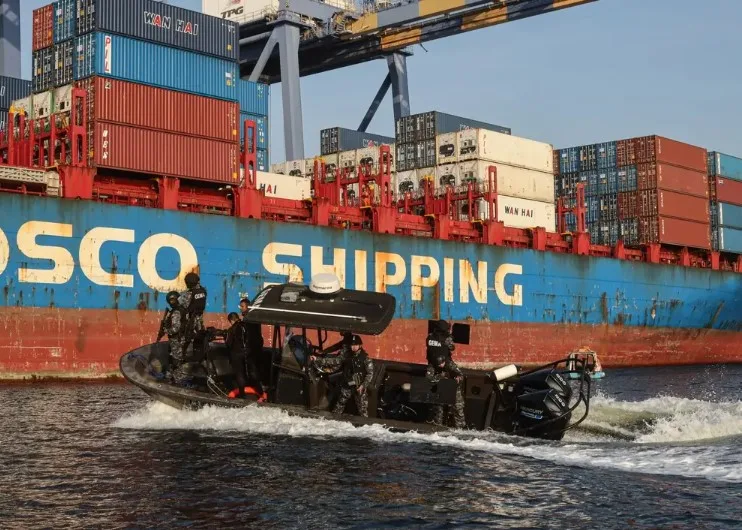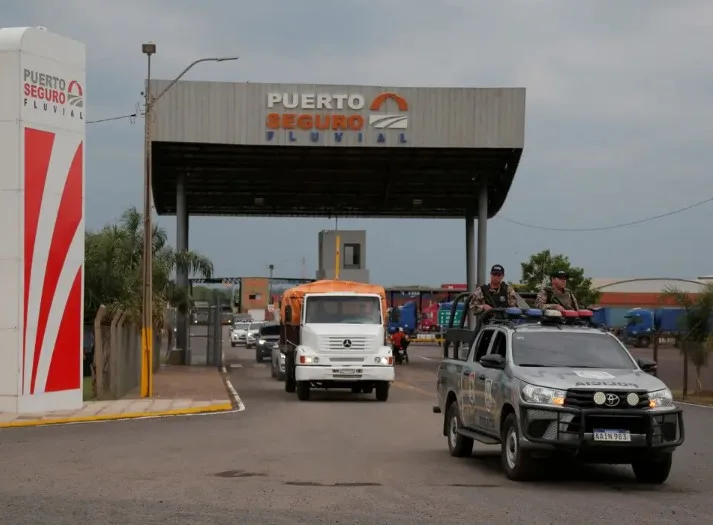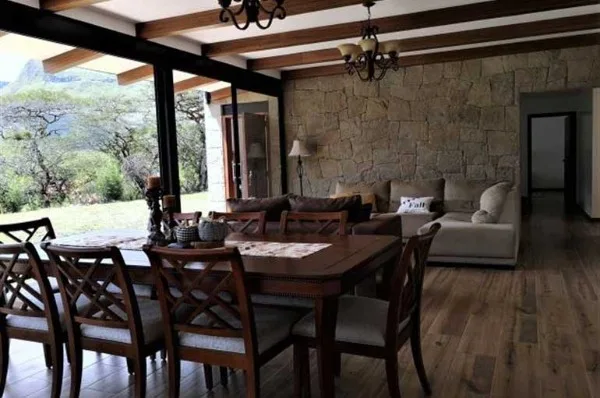Europe’s cocaine addiction is destabilizing South America. EU countries may be next
By Alexander Busch
In August last year, contract killers shot and killed Ecuadorian presidential candidate Fernando Villavicencio. He had previously denounced links between the Los Choneros drug gang and top judicial, military and political figures – and revealed that he had received death threats. Shortly afterward he was dead.

Members of the Ecuadorian Special Mobile Group to Combat Drugs patrol the port of Guayaquil.
The Los Choneros gang is said to have issued the contract for his murder. However, this has not been proven. A number of suspects in the shooting were murdered in prison after their arrest.
Five months later, drug-trafficking crime groups in Ecuador are once again challenging the state. Earlier this month, they paralyzed the country with bomb attacks, kidnappings and the occupation of a TV station. Leading gang bosses were allowed to leave high-security prisons unmolested. President Daniel Noboa, who has just taken office, has declared a state of emergency and sent the military after the drug gangs.
New level of brutality
In Ecuador, the battle between narcos and the government, which is taking place everywhere in South America, is being taken to a new, more intense level. Organized crime groups have openly declared war on the government. In South America, this has previously only ever happened in Colombia. There, however, it also had a political dimension for some time, because the FARC guerrillas saw themselves as liberators of the country, and justified their drug trafficking by claiming it was financing the left-wing revolution.
The war for market share and control of drug routes in Latin America is particularly intense in Mexico. Drug cartels have long controlled entire federal states there. The national government has lost sovereignty over large parts of the country. Murder rates are notoriously high. When politicians or experts in South America warn of the emergence of «Mexican conditions» in their countries, Mexico’s government is outraged.
But Ecuador is now showing that there is also a threat of open conflict with the cartels in South America, just as in Mexico. This is currently the biggest challenge facing the region’s countries – and will remain so in the coming years.
The growing geographical influence of drug gangs in South America is due to the fact that they have been exporting larger quantities of cocaine every year for the past 10 years, primarily to Europe. Colombian drug gangs have been looking for new markets for the drug, which is produced almost exclusively in Colombia, Peru and Bolivia.
Mexican cartels control business in the U.S.
The traditional channels for exporting cocaine to the U.S., either directly or via Central America, continue to function but are no longer growing. The Mexican drug cartels have a monopoly on the shipment of cocaine to the United States. As smugglers and providers of weapons and money, they capture the largest share of profits in the U.S. market.

Police in Uruguay guard cocaine seized in a recent raid.
In Europe, on the other hand, a new, growing and high-priced market for cocaine has emerged. According to Europol, this market has today become even more important for the drug mafias than the United States. Cocaine is now the second-most commonly used drug in Europe after cannabis. According to the United Nations’ drug report, more cocaine residue is detected in Europe’s wastewater than anywhere else in the world. More cocaine has been seized in Europe than in the U.S. every year since 2019.
At the same time, more cocaine is being produced than ever before. According to the U.N.’s World Drug Report 2023, cocaine production volumes have increased by two and a half times since 2015. In Colombia in particular, which produces 70% of the world’s cocaine, coca cultivation has been massively expanded. During the peace negotiations with the guerrillas there, the state effectively relinquished control over large parts of the country — as much as 15%, according to some sources.
The gangs are looking for easily controllable transport routes that they can use to get the drugs to wealthy Europeans. All of South America’s port cities now have major problems with drug smuggling. Guayaquil in Ecuador and Santos in Brazil are regarded as the most important smuggling ports. But even in comparatively safe countries not previously known as drug corridors, ports are today being used for smuggling. This can be seen in Montevideo in Uruguay or Valparaíso in Chile, for example.
Transit route and consumer market
Cocaine transit has also made South America the third-most important consumer market in the world after the U.S. and Europe. Latin America is home to a broad middle class of around 150 million people who might conceivably consume cocaine. However, gangs also see the pool of poor people who smoke crack as an attractive market. There are crack districts in all cities today.
The traditional drug mafias have roped in local criminal gangs and provided them with incentives to engage in the business. There are now several dozen drug gangs in every country in the region, most of which are controlled from prisons, as recently seen in Ecuador. These gangs engage in brutal conflict with one another – but sometimes work together across national borders.

A worker at a cocaine processing facility in Putumayo. Colombia displays his dirty hands.
Albanian and Mexican mafias call the shots in Ecuador in cooperation with local gangs. In Brazil, Italian mafias have long been working with local groups such as the PCC, the powerful Brazilian prison mafia originating from São Paulo, South America’s largest city. Tren de Aragua from Venezuela is active in Chile, Peru, Argentina and the Amazon region – wherever Venezuelans have migrated in recent years.
The gangs infiltrate state and economic institutions, subverting the judiciary, the police, political parties and parliaments. Every local journalist knows the deputies, senators, judges and police chiefs who are paid by the gangs or are themselves even leading members of the organizations.
The growing presence of drug mafias within state institutions is weakening efforts to crack down on crime. Corrupt officials or judges are able to neutralize the effect of otherwise successful police actions. As a result, other kinds of illegal activities are also becoming more common in the wake of drug trafficking.
Drug money in the legal economy
When drug sales falter, as they did during the COVID-19 pandemic, criminals turn to extorting protection money from small and medium-sized entrepreneurs or even to kidnapping as an alternative. The drug money also facilitates other criminal activities. For example, the drug gangs in the Amazon region finance illegal logging and gold mining. This allows them to increase their profits.
Drug cartels everywhere are channeling illegal money into the legal economy in order to launder it. This is less noticeable in large economies such as Brazil than in small countries such as Uruguay or Ecuador.

Police officers in Paraguay escort a confiscated truck holding cocaine that was to be loaded onto a ship bound for Europe.
The region’s countries are currently taking one of two approaches to the drug gangs – tolerance or repression.
Some governments try to keep crime under control by tolerating the drug business. Under this model, the states largely leave the drug business alone, with the proviso that the gangs keep general crime under control. No government openly admits to negotiating such deals with the criminal groups.
But this is how it works with Brazil’s PCC, for example, and the crime rate in São Paulo has fallen. However, in the case of clashes between the gangs, agreements like this are of little use, as recent explosions of violence in Brazil, Ecuador and Chile over the past 12 months show.
Ineffective clampdown
Repression also appears increasingly unpromising. The region’s public security forces are hopelessly overmatched by the gangs’ growing military power – especially as they too are being infiltrated by the criminal groups, and are thus losing both effectiveness and credibility.
To fight the drug gangs more effectively, countries would need to increase cooperation and exchange information more effectively. But initiatives of this kind are still in their infancy. Even in large countries such as Brazil or Argentina, provincial and federal police units tend to work in isolation from one another, even when focusing on the same territories. It sometimes seems as if there is hardly any interest in taking genuinely effective action against the gangs.
Warning for Europe
The explosive security situation in South America should serve as a warning to Europe. This is because there is an increasing risk that the drug gangs’ practices will filter into Europe along with their cocaine. The Netherlands is a glaring example of how drug crime is escalating as smuggling increases. Journalists are being shot there, and judges are being threatened.
In Europe, too, all ports and their surrounding areas are experiencing growing problems due to the explosion in cocaine smuggling. It is only a matter of time before the police, judiciary, customs services and prisons are infiltrated. The mafias simply have too much money at their disposal due to the strong demand for cocaine to think otherwise. In Europe, too, there is a confusing network of overlapping competencies and responsibilities in the fight against drug trafficking.
Cooperation with the authorities in South America is suffering as a result. Drug investigators there complain that the institutions in Europe are also a hopeless mess.
It does not seem to be a question of whether, but rather of how quickly the problems associated with cocaine trafficking will take root in Europe. As long as consumers are prepared to spend money on the powder from the Andes, police officers, port workers, judges and lawyers will fall under the gangs’ influence. With this will come all the well-known problems for public safety.
__________________
Credit: NZZ





















